I am trying to plot a regression tree generated with rpart using partykit. The code that generates the tree is this one:
library("rpart")
fit <- rpart(Price ~ Mileage + Type + Country, cu.summary)
library("partykit")
tree.2 <- as.party(fit)
plot(tree.2, type = "simple", terminal_panel = node_boxplot(tree.2,
col = "black", fill = "lightgray", width = 0.5, yscale = NULL,
ylines = 3, cex = 0.5, id = TRUE))
I am trying to modify the boxplots on the terminal nodes so that the y axis is on the log scale.
I am aware that when trying to make a boxplot all we have to do is to specify boxplot(data, log="y"). Which is why I tried to modify the function node_boxplot only in the single line where the function boxplot is used. However I keep getting the same graph. Is there something I am missing? Any feedback would be greatly appreciated.
node_boxplot2<-function (obj, col = "black", fill = "lightgray", bg = "white",
width = 0.5, yscale = NULL, ylines = 3, cex = 0.5, id = TRUE,
mainlab = NULL, gp = gpar())
{
y <- log(obj$fitted[["(response)"]])
stopifnot(is.numeric(y))
if (is.null(yscale))
yscale <- range(y) +c(0,0.1)* diff(range(y))
rval <- function(node) {
nid <- id_node(node)
dat <- data_party(obj, nid)
yn <- dat[["(response)"]]
wn <- dat[["(weights)"]]
if (is.null(wn))
wn <- rep(1, length(yn))
x <- boxplot(rep.int(yn, wn),plot = FALSE)
top_vp <- viewport(layout = grid.layout(nrow = 2, ncol = 3,
widths = unit(c(ylines, 1, 1), c("lines", "null",
"lines")), heights = unit(c(1, 1), c("lines",
"null"))), width = unit(1, "npc"), height = unit(1,
"npc") - unit(2, "lines"), name = paste("node_boxplot",
nid, sep = ""), gp = gp)
pushViewport(top_vp)
grid.rect(gp = gpar(fill = bg, col = 0))
top <- viewport(layout.pos.col = 2, layout.pos.row = 1)
pushViewport(top)
if (is.null(mainlab)) {
mainlab <- if (id) {
function(id, nobs) sprintf("Node %s (n = %s)",
id, nobs)
}
else {
function(id, nobs) sprintf("n = %s", nobs)
}
}
if (is.function(mainlab)) {
mainlab <- mainlab(names(obj)[nid], sum(wn))
}
grid.text(mainlab)
popViewport()
plot <- viewport(layout.pos.col = 2, layout.pos.row = 2,
xscale = c(0, 1), yscale = yscale, name = paste0("node_boxplot",
nid, "plot"), clip = FALSE)
pushViewport(plot)
grid.yaxis()
grid.rect(gp = gpar(fill = "transparent"))
grid.clip()
xl <- 0.5 - width/4
xr <- 0.5 + width/4
grid.lines(unit(c(xl, xr), "npc"), unit(x$stats[1], "native"),
gp = gpar(col = col))
grid.lines(unit(0.5, "npc"), unit(x$stats[1:2], "native"),
gp = gpar(col = col, lty = 2))
grid.rect(unit(0.5, "npc"), unit(x$stats[2], "native"),
width = unit(width, "npc"), height = unit(diff(x$stats[c(2,
4)]), "native"), just = c("center", "bottom"),
gp = gpar(col = col, fill = fill))
grid.lines(unit(c(0.5 - width/2, 0.5 + width/2), "npc"),
unit(x$stats[3], "native"), gp = gpar(col = col,
lwd = 2))
grid.lines(unit(0.5, "npc"), unit(x$stats[4:5], "native"),
gp = gpar(col = col, lty = 2))
grid.lines(unit(c(xl, xr), "npc"), unit(x$stats[5], "native"),
gp = gpar(col = col))
n <- length(x$out)
if (n > 0) {
index <- 1:n
if (length(index) > 0)
grid.points(unit(rep.int(0.5, length(index)),
"npc"), unit(x$out[index], "native"), size = unit(cex,
"char"), gp = gpar(col = col))
}
upViewport(2)
}
return(rval)
}

